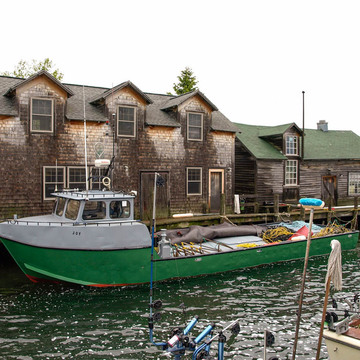Fishtown survives as a place where a community of fishermen, residents, summer people, merchants, and tourists have come together to sustain an authentic accessible commercial and sports fishing village. In 1853, Antoine Manseau (1810–1856) built a sawmill at the confluence of the Carp River, now the Leland River, and Lake Michigan. Just upstream he and John I. Miller (b. 1822) built a dam. From 1870 to 1884 the Leland Lake Superior Iron Company smelted iron ore from the Upper Peninsula here. In the 1870s commercial fishermen began using the Carp River, and fishing, pig iron, and lumber became Leland's industries. In 1886 the construction of a breakwater, improved in 1937 and 1966, provided Leland with a good harbor and helped the fishing industry. At its peak, eight full-scale commercial fishing businesses operated here.
From the dam to its mouth, the Leland River is lined with docks, shanties on pilings, and boats. Fishermen built the wood and shingled shanties as places in which to store and repair nets and clean and sell fish. Next to them are net racks, and behind are icehouses, smokehouses, and gas sheds. A network of dirt paths connects the village. After World War II the sea lamprey devastated the Great Lakes whitefish and lake trout industry. In 1979 the federal court recognized the Native American treaty rights for fishing. Today fish shanties shelter shops and art studios patronized by tourists. Shingle-roofed Falling Waters Lodge (1964–1965, Arai and Hummel) at 200 Cedar Street and the Cove restaurant (1966) at 111 River Street flank the river at the dam. To avert the immediate danger of losing this commercial and sports fishing village to development and to keep it accessible to the public, in 2007 the Fishtown Preservation Society (FPS) purchased Fishtown, two fish tugs, and fishing licenses. FPS maintains and preserves Fishtown. The Joy and the Janice Sue were rehabilitated in 2009 and resumed fishing; Steffens Stallman Shanty was rehabilitated to plans of Richard A. Neumann in 2010. A historic structures report was completed in 2011.















